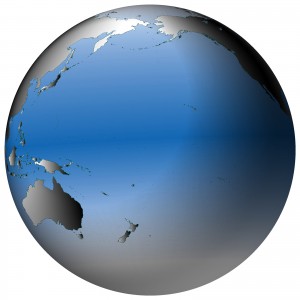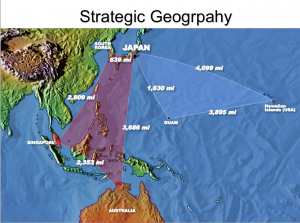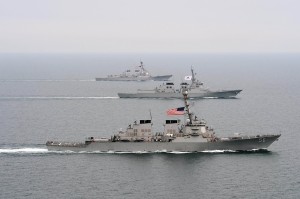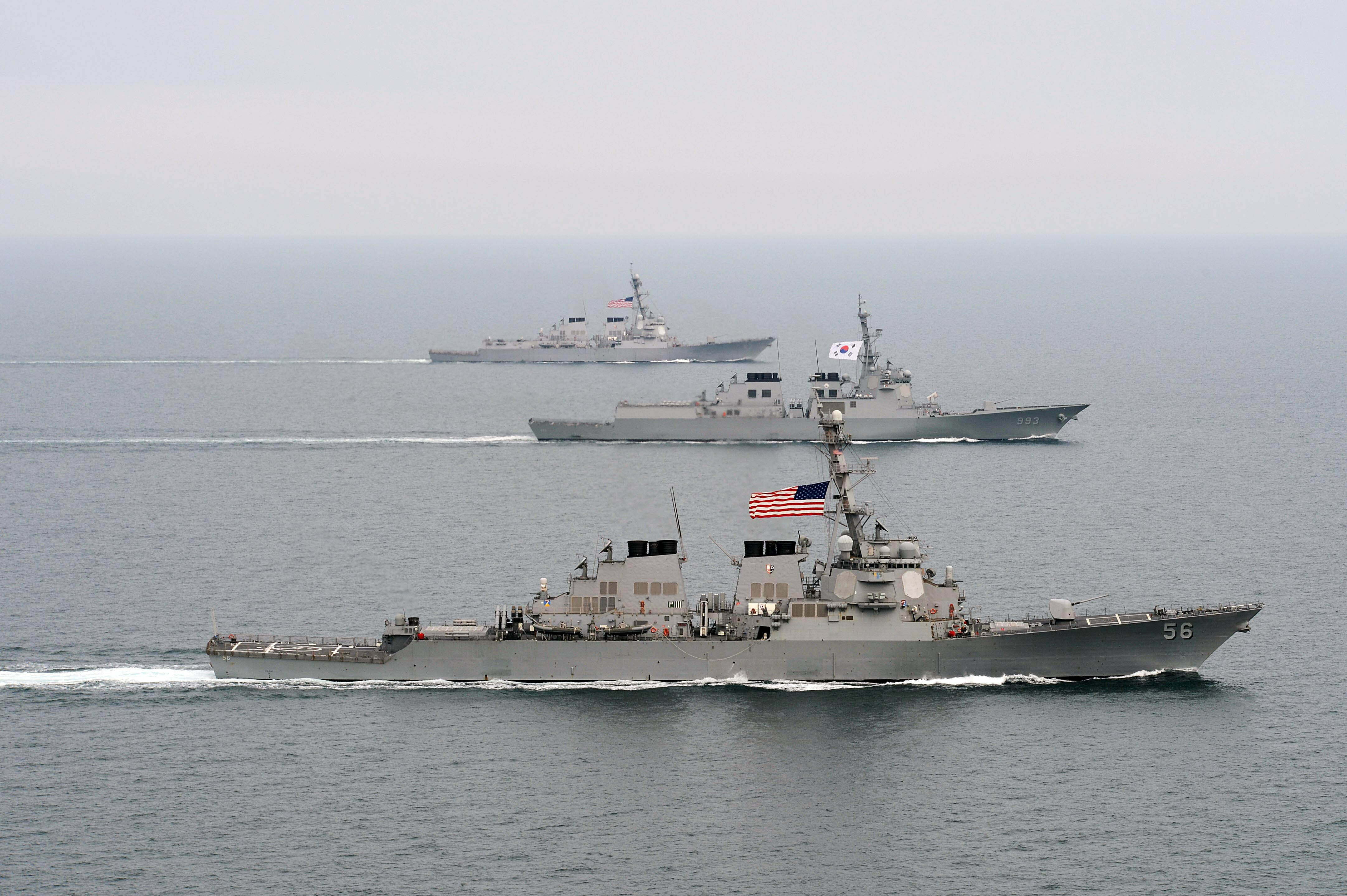2015-08-19 By Robbin Laird
In my last piece based on my time with MARFORPAC and PACFLEET, I want to highlight some perspectives gained from talking with four members of the PACFLEET staff.
I had a chance to talk with an learn for four senior members of the PACFLEET staff in addition to the earlier interviews published recently.
Captain Mark “JP” Sousa is PACFLEET Liason to PACAF and focuses on C2 issues in working the evolution of the force. He operates from the 613th Air Operations Center at Hickam.
Captain Sousa is a former Tomcat pilot, and given the key role which the F-14s played in the chain saw strategy for the carrier battle groups, it is not surprising that the F-14 pilots are playing a key role in the Navy’s transition to distributed operations.
The head of Naval Air Warfare as well as the head of PACFLEET operations are both former F-14 pilots.

It is important to underscore how the F-14 operational experience anticipates in some ways the coming of the F-35 to the fleet and its impact on C2, ISR and strike.
As Ed Timperlake puts it:
“The USAF had real early experience with stealth with the F-117 Nigh Hawk leading the way. Concurrently the Navy had excellent experience with their F-14 fighter community in developing technology, a state-of-the art radar and a missile Aim-54, that could reach out and touch someone.
After the Vietnam War, the US Navy introduced the F-14 and began again the never ending process of always evolving the training, tactics and command and control to push the threat from a reactive enemy out as far as possible from a Carrier Battle Group (CBG).
The CBG could then conduct combat strikes against all targets, land air and sea.
This evolution of reach and range technology and cockpit enhanced situational awareness driving training and tactics will be soon be seen in the nature of changing command and control relationships as the F-35 enters the Sea Services inventory.”
(See also, https://www.sldinfo.com/shaping-an-operational-strategy-in-the-pacific-an-interview-with-rear-admiral-john-aquilino/).
Captain Kevin Melody works ballistic missile and air defense issues for PACFLEET and has significant experience with the surface fleet, including Aegis.
Captain Patrick Walsh is director of Deliberate Planning for PACFLEET and as the title suggests is focused upon the planning process in dealing with current and evolving threats.
And finally Captain Patrick Molenda is the Operations Deputy, Staff of the Commander, Pacific Fleet and steered me through the PACFLEET interview process during my time in Honolulu.
What clearly comes across is that PACFLEET is clearly aware of the various challenges facing the Navy, the Marine Cops and the joint force in the Pacific, including the Chinese reaching out into the Pacific.
They are stepping up to the challenges, and are focused on shaping a more effective force, one which can operate over an extended battlespace, with distributed C2 and a more integrated joint and coalition sensor set from which warfighting solutions can be informed.

The effort to shape a new combat approach will not be easy; and will take technology investments, training, operational experience and shaping lessons learned from that experience as well as shaping the combat skill necessary to execute in a 21st century Pacific security and defense environment.
The shift from the preoccupation with the land wars in an area of the world far from the Pacific to Pacific operations is not an easy one.
Many skills learned there need to be shed and new skills learned.
Operating in a slow moving war with air dominance to a theater with the tyranny of distance, allies shaping new capabilities which need to be worked with those of the American forces, and forging ways to operate in contested areas in higher tempo operations is a challenging shift.
An aspect of the change is clearly with regard to C2.
The C2 revolution is clearly an important one inherent in some of the new platforms and technologies which have come or are coming to the Pacific, such as the P-8, the Global Hawk and the F-35.
Forging ways to do distributed C2 in contested areas is the challenge; this means learning how to aggregate and disaggregate force given disruptions adversaries will try to create with deployed US and allied forces.
Captain Sousa highlighted two significant C2 challenges for the joint force.
The first is as the appropriate force mix is shaped, who is the supported and supporting force commander and how to establish the proper C2 relationship so that the proper force mix can operate effectively?

The second is dealing with disrupted communications for a deployed distributed force. During the most recent Unified Engagement exercise, the challenge of disrupted communications was a key element, and the Navy-Air Force team worked the problem of shaping an effective deployed operation in the face of communications disruptions.
In effect, the ability of the joint force to aggregate and disaggregate forces enabled by a robust communications system is the way ahead within which a honeycomb force – one in which force packages can operate as discrete packages – or be combined across the battlespace is the way ahead.
Captain Melody focused on the importance of shaping a more integrated approach to combining sensors informing operations.
As one created what we have called the 21st century “big blue blanket” of Pacific wide sensors, those sensors can be tapped into to shape more effective mission performance.
Melody underscored that the integration of sensors should not be confused with the integration of missions. “Air and missile defense are very different missions.
Shaping more effective integration of sensors is beneficial to both, but does not lead to the integration of the very different missions.”
http://www.usni.org/magazines/proceedings/2012-01/long-reach-aegis
https://www.sldinfo.com/army-ada-as-key-element-of-21st-century-attack-defense-enterprise/
All four Naval officers underscored the importance of training for 21st century operations and are concerned with training shortfalls, whether due to the continuing combat rhythm in the Middle East or resource shortfalls.
It was pointed out that carrier time in the Pacific is too often transit time somewhere else and is not about providing support for the kind of 21st century training and exercises crucial for a deterrence in depth strategy in the Pacific.
Whether it be training for deconfliction of forces, more effective aggregation of forces, more effective disaggregation of resources, all of this is different in higher tempo operations than has been the coin of the realm in the Middle East wars ongoing and in the past decade.
Both Walsh and Molenda highlighted the importance of getting the training and exercise commitments to enable the force to implement effective plans appropriate for higher tempo 21st century operations.
Ed Timperlake often makes the point (he is a Naval Academy graduate) that the fighting Marine Corps and the Navy in the Pacific is more than up to meeting Pacific challenges.
Clearly, the USN-USMC team needs the intellectual and financial support from Washington to do the job.
But the trajectory to mission success is clearly underway. Visiting PACFLEET and MARORPAC only reinforced Timperlake’s point.
Editor’s Note:
For additional insights from Captain Molenda, see the following:
http://www.usni.org/magazines/proceedings/2015-05/silence-net
Mission command is the missing link in the Navy’s quest for information dominance.
http://www.usni.org/magazines/proceedings/2014-07/time-next-revolution
The “Admiral Turner Revolution” of the 1970s reinvigorated the Naval War College. Today, a similar transformation in the approach to officer education is needed.
A contributing factor to the problem of relevancy is that although the Naval War College is widely recognized throughout the Navy, joint community, inter-agency, and academia as an educational organization of the highest caliber, oddly enough, the Navy typically does not send its best and brightest to Newport, either as students or instructors.
Assignment to the Naval War College does not rise to a level of prominence compared to Navy enterprise, OPNAV, or even joint billets.
Though there are exceptions, hot runners from all warfare specialties are most often advised that they do not have time in their career progression to “waste a year” in Newport . . . and so they don’t go.
And in a recent presentation on the Hill, Timperlake underscored the significant gap between the USN and joint forces approach in the Pacific to able to deal with Chinese efforts at anti-access and area denial and the tendency among some inside Washington to ascribe capabilities to the Chinese, which they simply aspire to but do not have.
For the interviews conducted in Hawaii in July 2015, see the following:


